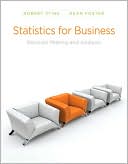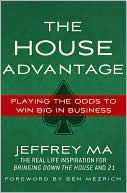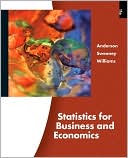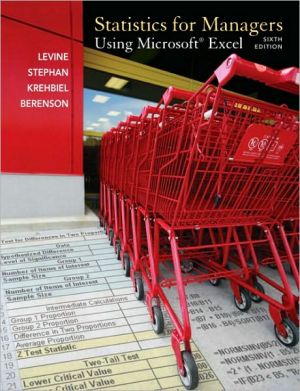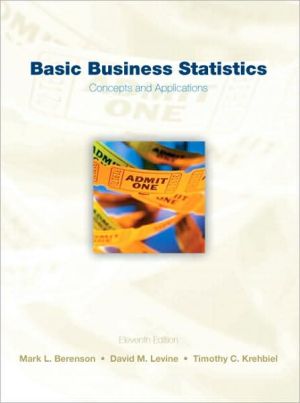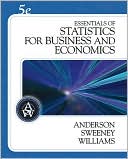Statistics for Business: Decision Making and Analysis
Search in google:
In the competitive world of business, effective decision making is crucial. To help you stand out from the crowd, Robert Stine and Dean Foster of the Wharton School of the University of Pennsylvania have written an exciting new book for business statistics. This book teaches you how to use data to make informed decisions; every chapter highlights issues in the modern business world. The authors provide strong connections between the statistical concepts in the text and the problems you will face in your future careers, showing you how to find patterns, create statistical models from the data, and deliver your findings to an audience.
PART 1: VARIATION IN DATA1. Introduction1.1 What is Statistics?1.2 Previews1.3 How to Use This Book2. Data2.1 Data Tables2.2 Categorical and Numerical Data2.3 Recoding and Aggregation2.4 Time Series2.5 Further Attributes of Data3. Describing categorical data3.1 Looking at Data3.2 Charts of Categorical Data3.3 The Area Principle3.4 Mode and Median4. Describing numerical data4.1 Summaries of Numerical Variables4.2 Histograms and the Distribution of Numerical Data4.3 Boxplot4.4 Shape of a Distribution5. Association in categorical data5.1 Contingency Tables5.2 Lurking Variables and Simpson's Paradox5.3 Strength of Association6. Association in numerical data6.1 Scatterplots6.2 Association in Scatterplots6.3 Measuring Association6.4 Summarizing Association with a Line6.5 Spurious CorrelationStatistics in Action: Financial time seriesStatistics in Action: Executive compensationPART 2: PROBABILITY7. Probability7.1 From Data to Probability7.2 Rules for Probability7.3 Independent Events7.4 Boole's Inequality8. Conditional Probability8.1 From Tables to Probabilities8.2 Dependent Events8.3 Organizing Probabilities8.4 Order in Conditional Probabilities9. Random Variables9.1 Properties of Random Variables9.2 Expected Values9.3 Comparing Random Variables10. Association between Random Variables10.1 Portfolios and Random Variables10.2 Probability Distribution10.3 Sums of Random Variables10.4 Measure Dependence between Random Variables10.5 IID Random Variables11. Probability models for Counts11.1 Random Variables for Counts11.2 Binomial Model11.3 Properties of Binomial Random Variables11.4 Poisson Model12. Normality12.1 Normal Random Variable12.2 The Normal Model12.3 Percentiles of the Normal Distribution12.4 Departures from NormalityStatistics in Action: Managing Financial RiskStatistics in Action: Modeling Sampling VariationPART 3: INFERENCE13. Samples and Surveys13.1 Two Surprises in Sampling13.2 Variation13.3 Alternative Sampling Methods13.4 Checklist for Surveys14. Sampling Variation and Quality14.1 Sampling Distribution of the Mean14.2 Control Limits14.3 Using a Control Chart14.4 Control Charts for Variation15. Confidence Intervals15.1 Ranges for Parameters15.2 Confidence Interval for the Mean15.3 Interpreting Confidence Intervals15.4 Manipulating Confidence Intervals15.5 Margin of Error16. Statistical Tests16.1 Concepts of Statistical Tests16.2 Testing the Proportion16.3 Testing the Mean16.4 Other Properties of Tests17. Alternative Approaches to Inference17.1 A Confidence Interval for the Median17.2 Transformations and Intervals17.3 Prediction Intervals17.4 Proportions Based on Small Samples18. Comparison18.1 Data for Comparisons18.2 Two-sample T-test18.3 Confidence Interval for the Difference18.4 Other ComparisonsStatistics in Action: Rare EventsStatistics in Action: Testing AssociationPART 4: REGRESSION MODELS19. Linear Patterns19.1 Fitting a Line to Data19.2 Interpreting the Fitted Line19.3 Properties of Residuals19.4 Explaining Variation19.5 Conditions for a Simple Regression20. Curved Patterns20.1 Detecting Nonlinear Patterns20.2 Reciprocal Transformation20.3 Comparing a Linear and Nonlinear Equation20.4 Logarithm Transformation20.5 Comparing Equations21. Simple Regression21.1 The Simple Regression Model21.2 Conditions for the Simple Regression Model21.3 Inference in Regression21.4 Prediction Intervals22. Regression Diagnostics22.1 Changing Variation22.2 Leveraged Outliers22.3 Dependent Errors and Time Series23. Multiple Regression23.1 The Multiple Regression Model23.2 Interpreting Multiple Regression23.3 Checking Conditions23.4 Inference in Multiple Regression23.5 Steps in Building a Multiple Regression24. Building Regression Models24.1 Identifying Explanatory Variables24.2 Collinearity24.3 Removing Explanatory Variables25. Categorical Explanatory Variables25.1 Two-sample Comparisons25.2 Analysis of Covariance25.3 Checking Conditions25.4 Interactions and Inference25.5 Regression with Several Groups26. Analysis of Variance26.1 Comparing Several Groups26.2 Inference in Anova Regression Models26.3 Multiple Comparisons26.4 Groups of Different Size27. Time Series27.1 Decomposing a Time Series27.2 Regression Models27.3 Checking ConditionsStatistics in Action: Analyzing ExperimentsStatistics in Action: Automated Regression Modeling
